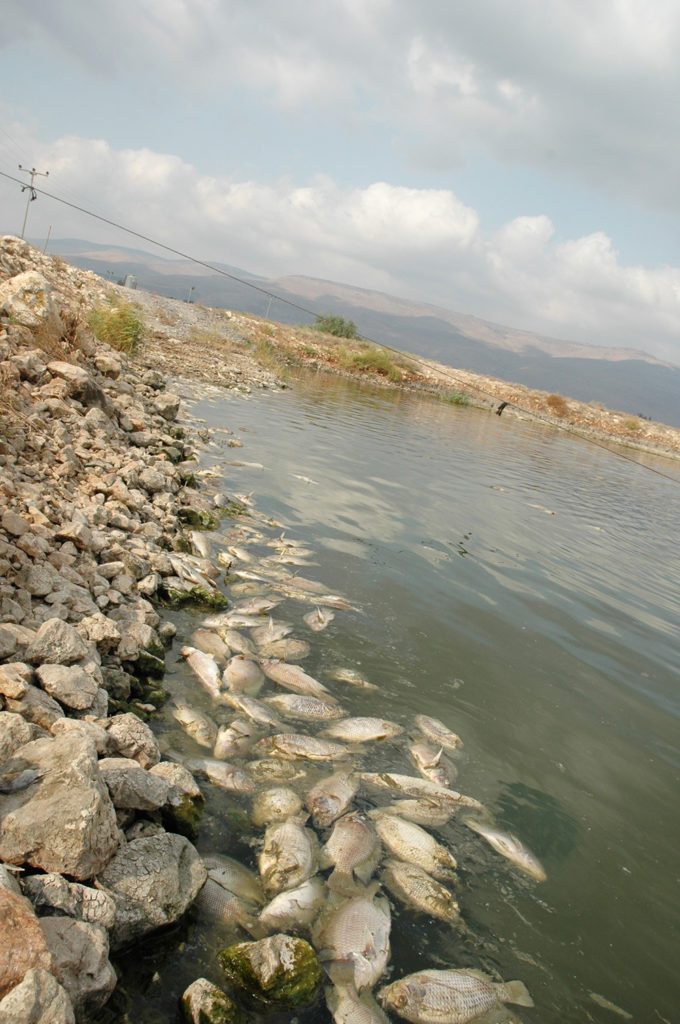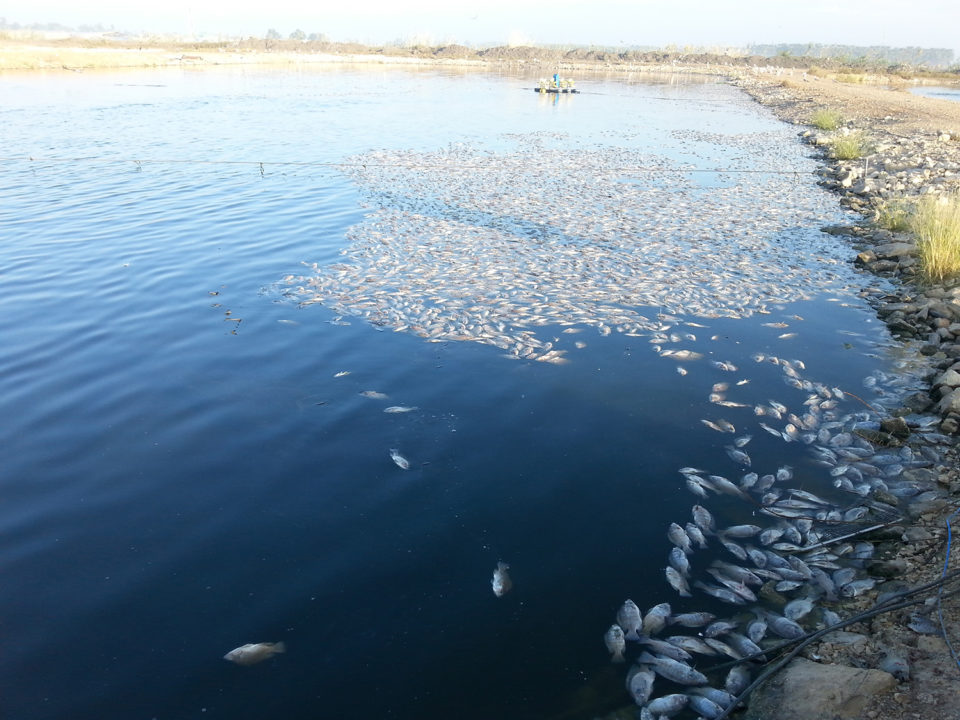Background: Tilapia lake virus (TiLV) is a novel RNA virus resembling Orthomyxovirus that causes syncytial hepatitis of tilapia (SHT) in Israel, Ecuador, Colombia, and Egypt (Ferguson et al., 2014; Eyngor et al., 2014; Bacharach et al., 2016; Del-Pozo et al., 2017, Fathi et al., 2017 in Dong et al., 2017).
TiLV is considered a potential threat to global tilapia aquaculture (Dong et al., 2017) because it caused a mortality of 90% in tilapia farms (Eyngor et al. 2014 in Dong et al., 2017).
It is crutial to pay attention to fish deseases in aquaculture so that they do not spread in the market. The following article is from Global Aquaculture Aliance written by Lauren Kramer and published in 17 July 2017:
Sizing up TiLV and its potential impact on tilapia production
Israeli researchers believe Tilapia Lake Virus could spread worldwide, and are working on a vaccine

TiLV has caused mass fish mortalities at farms in the Bet-Shean Valley in Israel. Photo courtesy of Avi Eldar, a veterinarian with the Kimron Veterinary Institute in Bet Dagan, Israel.
“18 researchers at five institutions in four countries are hard at work trying to find a solution for Tilapia Lake Virus (TiLV), a contagion causing high rates of mortality in farmed and wild tilapia stocks in Israel, Colombia, Ecuador, Egypt and Thailand.
Tilapia is farmed in 80 countries worldwide but the leading producers of this protein staple are China, Indonesia and Egypt. There have been no reports of an outbreak of TiLV in China to date, but Han Han, executive director of the China Blue Sustainability Institute, said the Chinese government is being urged to begin field investigations.
“Right now we’re going through a high-temperature season during which tilapia easily get sick,” she noted. “Most symptoms reported from farms showed regular afflictions, not new or strange viruses, and we’ve heard of no particular fears or concerns about TiLV among our partners to date.”
Avi Eldar, a veterinarian with the Kimron Veterinary Institute in Bet Dagan, Israel, was one of the first to link tilapia mortalities to TiLV back in 2010. “At that time we saw tilapia catches decrease in the Sea of Galilee and suspected it was a virus,” he said. “We sent samples to reference labs and colleagues across the world but no-one could point towards a known agent.”
Eldar approached Eran Bacharach, a colleague and molecular virologist at Tel Aviv University and together they began examining the cytopathic effects of TiLV.
“In our initial experiments we induced the disease in cells and found that a small portion of the tilapia survived the infection,” Bacharach said. “Those fish were immune to further exposures of the virus, which told us that immunization, in principle, could be achieved. So we started thinking about ways to vaccinate the fish.”
“With such high mortality rates, TiLV has real potential to be devastating to the industry.”
“That vaccination is years, not weeks, away”, Bacharach said.
“We have a few approaches to inducing immunity to this pathogen in tilapia populations. One is keeping an attenuated strain of the virus alive with the ability to replicate, yet without its virulence,” Bacharach added. “Another is to generate an inactive virus, i.e. one unable to replicate, and expose the fish to that virus. A third approach, called Subunit Vaccine, involves expressing a limited set of the proteins derived from TiLV and exposing the fish to this.”

Dead tilapia along the shore of a fish pond in the Bet-Shean Valley in Israel. Photo courtesy of Avi Eldar.
The researchers are also trying to identify tilapia strains or species that are less susceptible to TiLV. “In this strategy, we try to hybridize these less susceptible fish with commercially grown fish,” Eldar said.
The two researchers are collaborating with others at Columbia University in New York, Edinburgh University in Scotland and St. George’s University in Grenada, West Indies. Grant funding has been supplied by a U.S.-Israel Binational Agricultural Research & Development Fund and a fellowship from the Manna Center Program in Food Safety and Security at Tel Aviv University.
But more funding is needed, Eldar said, anticipating the challenge ahead. “This is a disease affecting poor countries in Africa and East Asia, not a disease found in Europe or North America,” he explained. “Tilapia, a major protein source and source of work in the developing world, is a food security issue, and not the next big issue for the fish industries in America or Europe, which is why more funding of our research is not readily available.”
Tilapia is the world’s second-most farmed fish, behind carps, estimated at between 4.5 and 5 million metric tons annually. Israel’s annual tilapia yields have plummeted up to 85 percent and similar mortality rates have been reported in Ecuador and Colombia. “For sure, with such high mortality rates, TiLV has real potential to be devastating to the industry,” Bacharach said.
“We were the first to report on this disease in Israel in 2014, the same year it was reported in Ecuador,” Eldar noted. “Since then, there have been more and more publications of outbreaks in Asia and South America and every week we’re approached by colleagues asking for information on how to culture and detect the virus. This leads us to believe that TiLV is occurring all over the world.”
While the Food and Agriculture Organization (FAO) says TiLV does not pose a risk to public health, it issued an alert through the Global Information and Early Warning System asking countries importing tilapia to intensify their diagnostics testing, enforce health certificates, deploy quarantine measures and develop contingency plans.


